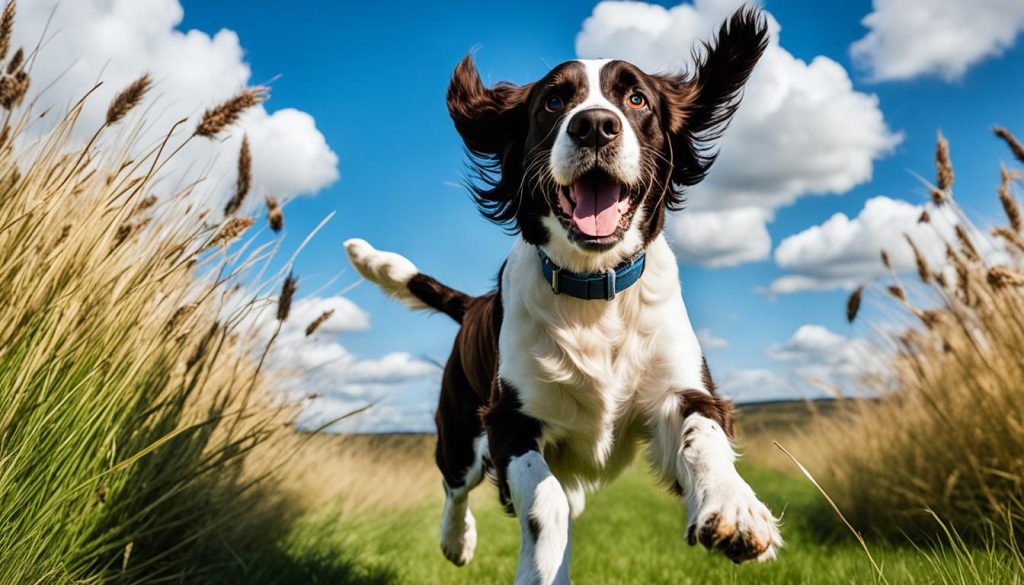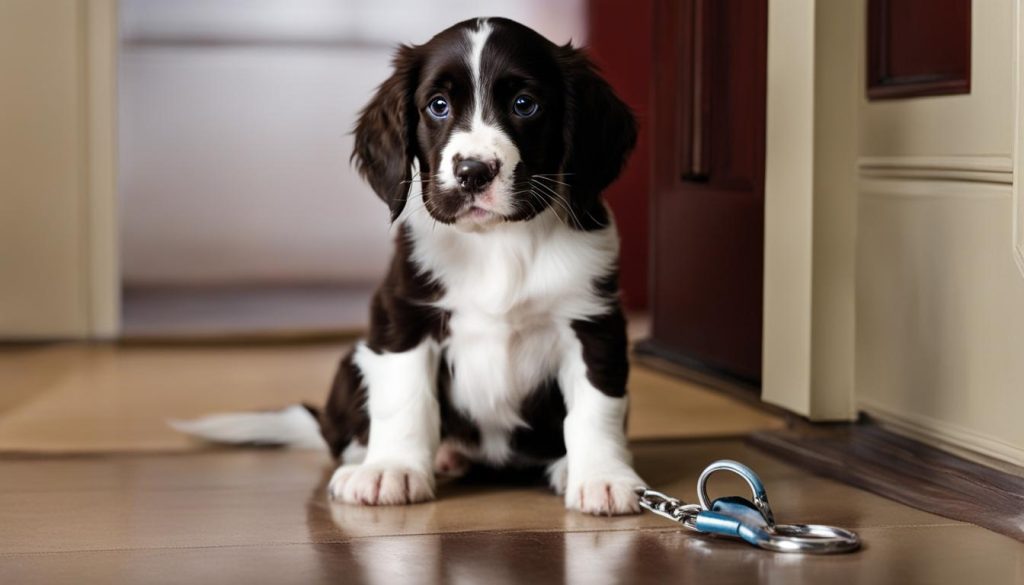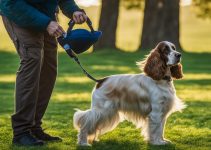In this article, I will share valuable tips to help you master English Springer Spaniel training. Whether you are looking to teach obedience commands, address behavioral issues, work on leash training, or housebreak your dog, these tips will provide you with the best training methods to ensure success.
When it comes to English Springer Spaniel training, it is important to maintain a calm and assertive demeanor as the dog owner. Consistency is key in correcting any behavioral issues and setting boundaries for your pet. Make sure to reward your dog with treats only when they have earned them by performing a command or demonstrating good behavior.
Starting training early when your Springer Spaniel is a puppy is crucial. This is the time to focus on housebreaking, teaching basic commands like “sit,” “lie down,” and “stay,” and gradually introducing more advanced commands such as walking on a leash, recall, leave, and fetch. Remember to keep training sessions short and frequent, making them fun and engaging for both you and your dog.
English Springer Spaniel Training
- Consistency and calm assertiveness are important in English Springer Spaniel training.
- Start training early, focusing on housebreaking and basic commands.
- Make training sessions short, frequent, and fun for both you and your dog.
- Reward your dog with treats for good behavior and performance of commands.
- Gradually introduce more advanced commands and behaviors as your dog progresses.
Establishing a Strong Bond in Springer Spaniel Training
Before starting English Springer Spaniel training, it is important to establish a strong bond with your English Springer Spaniel. Building a trusting and connected relationship with your dog is the foundation for successful training. By spending quality time playing and engaging in activities that your dog enjoys, you can strengthen your bond and create a positive association with training.
Positive reinforcement and praise play a vital role in establishing this bond. When your Springer Spaniel exhibits desirable behaviors or follows your commands, reward them with treats and enthusiastic praise. This positive reinforcement reinforces the trust between you and your dog, making them more receptive to your training methods.
Train in a calm and relaxed environment to help your dog feel secure and comfortable. English Springer Spaniel training sessions should be enjoyable for both you and your pet. Engage in games and activities that challenge your Springer Spaniel mentally and physically, further enhancing the bond between you.
Remember that trust and connection are not built overnight. Consistency is key, and it may take time for your dog to fully trust and rely on you as their trainer. Stay patient, understanding, and nurturing throughout the training process, and your efforts will be rewarded with a strong bond and a well-trained English Springer Spaniel.
Teaching the Recall Command in Springer Spaniel Training
Teaching your English Springer Spaniel to come when called is an essential skill in training. To ensure success, start by choosing a distinct command word, such as “come” or “here.” This will help your dog understand and respond to the specific recall command. Remember, consistency is key.
Begin training in a controlled and distraction-free environment. This will allow your Springer Spaniel to focus and understand what is expected. As your dog becomes more reliable in responding to the recall command, gradually introduce distractions to create real-life scenarios.
Positive reinforcement is a powerful tool in teaching the recall command. Use praise and treats to reward your dog for coming when called. Make yourself interesting and rewarding to your dog during training sessions to encourage their response.
It is important to note that punishment should be avoided when your dog does not immediately respond to the recall command. Instead, be patient and persistent in your English Springer Spaniel training. With time and practice, your Springer Spaniel will learn to come when called reliably.

Remember, teaching the recall command requires consistency, positive reinforcement, and patience. By establishing a distinct command word, training in a controlled environment, and rewarding your dog’s response, you can ensure that your English Springer Spaniel comes back to you every time you call.
Leash Training in English Springer Spaniel Training
Leash training is an essential aspect of English Springer Spaniel training. It helps promote good behavior and ensures a safe and enjoyable walking experience for both you and your dog. Here are some important tips to help you successfully leash train your Springer Spaniel.
1. Introduce the leash gradually: Start by introducing your dog to the leash in a positive and gentle manner. Allow them to sniff and explore the leash before attaching it to their collar or harness. This helps them become familiar and comfortable with the leash.
2. Reward good behavior: Use positive reinforcement to reward your dog for walking calmly beside you without pulling on the leash. Whenever your dog stays close to you and walks politely, praise them and offer treats or verbal encouragement. This positive reinforcement encourages your dog to associate walking on a leash with pleasant experiences.
3. Start in a controlled environment: Begin leash training in a controlled and familiar environment, such as your home or a fenced yard. This helps minimize distractions and allows your dog to focus on learning to walk on a leash without being overwhelmed.
4. Gradually increase distance and distractions: As your dog becomes more comfortable with leash training in a controlled environment, gradually increase the distance between you and your dog. This helps them learn to walk on a loose leash even when you’re farther away. Introduce distractions gradually, such as other dogs or enticing smells, to teach your dog to stay focused on walking with you.
5. Use verbal cues: Teach your Springer Spaniel specific verbal cues to encourage appropriate leash behavior. For example, use phrases like “heel,” “let’s go,” or “easy” to guide your dog’s walking behavior. Consistency in using these cues helps your dog understand what is expected of them.
6. Be patient and consistent: Leash training takes time and patience. Be consistent in your training sessions and maintain a calm and positive attitude. Stay patient even if your dog initially struggles or gets distracted. With practice and persistence, your Springer Spaniel will learn to walk politely on a leash.
To reinforce the importance of positive reinforcement and controlled training approaches, remember that every dog learns at their own pace. The goal of leash training is to create a positive experience for both you and your furry companion. So, be patient, stay consistent, and enjoy the journey of teaching your Springer Spaniel to walk confidently on a leash!
Housebreaking in Springer Spaniel Training
In English Springer Spaniel training, housebreaking is a crucial aspect that requires consistency and positive reinforcement. Properly housebreaking your English Springer Spaniel sets the foundation for a well-behaved and clean dog.
To establish successful housebreaking, it is essential to establish a consistent schedule. Take your dog outside frequently, especially after meals, drinking water, or waking up from a nap. This routine helps your Springer Spaniel understand when and where they should go potty.
Choose a designated potty spot in your yard or designated area. This helps your dog associate a specific location with going potty. When they eliminate in the designated spot, be sure to reward them with praise and treats to reinforce the desired behavior.
Accidents may happen during the housebreaking process, especially in the early stages. If your dog has an accident indoors, it is essential to clean it up thoroughly without scolding or punishing your dog. Punishment can create anxiety and confusion, hindering the housebreaking process. Instead, focus on positive reinforcement to encourage your Springer Spaniel to continue going outside to do their business.

Consistency is key when housebreaking your Springer Spaniel. Stick to the established schedule and continue reinforcing the positive behavior. With patience and persistence, your English Springer Spaniel will learn to associate the designated potty spot with going potty and become well-trained in housebreaking.
Behavioral Training in Springer Spaniel Training
Behavioral training is a crucial aspect of English Springer Spaniel training. It focuses on teaching your dog appropriate behaviors and helping them learn impulse control. By using positive reinforcement techniques and consistent training, you can shape your dog’s behavior effectively.
Stopping Jumping
Jumping is a common behavior in dogs, including Springer Spaniels. To stop this behavior, it’s important not to reward it. Avoid giving attention or affection when your dog jumps on you. Instead, teach them alternative behaviors like sitting calmly or offering a toy. Consistency is key in reinforcing the desired behavior.
Impulse Control
Impulse control is an essential skill for any well-behaved dog. Teach your Springer Spaniel to wait patiently for things they want, such as food or toys. Start by asking your dog to “wait” before giving them the desired item. Gradually increase the duration of waiting and reward them for their patience. This helps develop their impulse control and improves their overall behavior.
Alternative Behaviors
In behavioral training, it’s important to teach your dog alternative behaviors to replace undesirable ones. For example, if your dog tends to bark excessively, teach them a quiet command and reward them when they stop barking. Redirecting their attention to an alternative behavior helps them understand what you expect from them.
Positive Reinforcement
Positive reinforcement is a powerful tool in English Springer Spaniel training. Use praise, treats, and rewards to reinforce good behavior. When your dog exhibits the desired behavior, immediately reward them to positively reinforce that behavior. This helps them understand what behaviors are acceptable and encourages them to repeat those behaviors in the future.
Remember, it’s important to avoid punishing your dog for not immediately responding. Instead, focus on positive reinforcement and consistency. Behavioral training takes time and patience, but with the right approach, you can shape your Springer Spaniel’s behavior effectively.
Socialization in Springer Spaniel Training
Socialization plays a crucial role in English Springer Spaniel training. It involves exposing your dog to various experiences, people, and pets, ensuring they develop positive associations and comfortable behavior in different social situations. As a responsible dog owner, it is important to prioritize socialization to help your Springer Spaniel become well-rounded and adaptable.
To promote socialization, introduce your dog to other pets, such as dogs and cats, in a controlled and supervised environment. This allows them to interact and become familiar with different animals. Gradually exposing your Springer Spaniel to other pets helps them develop social skills and learn appropriate behavior when interacting with other animals.
Additionally, it is essential to gradually expose your English Springer Spaniel to different people, including children. Create positive experiences by encouraging gentle interactions, supervised play sessions, and rewarding calm and polite behavior. By doing so, you can help your Springer Spaniel develop positive associations with children and learn how to interact with them in a friendly and appropriate manner.
Remember, gradual exposure is key to successfully socializing your Springer Spaniel. Start with controlled settings and gradually introduce new experiences, people, and pets as your dog becomes more comfortable. Providing positive experiences during socialization ensures that your dog associates these situations with pleasant feelings, fostering a confident and well-socialized companion.
- Introduce your English Springer Spaniel to other pets, such as dogs and cats, in a controlled and supervised environment.
- Gradually expose your dog to different people, including children.
- Ensure all experiences are positive, reinforcing good behavior with praise and rewards.
- Start with controlled settings and gradually increase exposure to new experiences and environments.
With dedicated socialization efforts, your English Springer Spaniel will become a well-rounded and sociable companion, comfortable in various social situations.
Conclusion
Training your English Springer Spaniel is a rewarding journey that requires patience, consistency, and the use of positive reinforcement techniques. Starting early and establishing a strong bond with your furry companion are the foundations for successful training.
Incorporate obedience and behavior training into your daily routine, focusing on teaching essential commands and shaping desired behaviors. Use positive reinforcement, such as praise and treats, to reward your Springer Spaniel for good behavior, making training sessions enjoyable and engaging for both of you.
Remember to be patient and persistent throughout the training process. Avoid punishing your dog and instead, redirect their behavior through alternative commands and rewards. With practice and dedication, your Springer Spaniel will become a well-trained and obedient companion, bringing you joy and harmony in your daily lives.
By following these successful training tips and using positive reinforcement, you can build a strong bond with your English Springer Spaniel, promote obedience and good behavior, and create a loving and lasting relationship with your furry friend.
FAQ
What are the best training methods for English Springer Spaniels?
The best training methods for English Springer Spaniels include positive reinforcement, consistency, and setting clear boundaries. It is important to establish a calm and assertive demeanor as the dog owner and make training sessions fun and engaging.
How can I establish a strong bond with my Springer Spaniel during training?
To establish a strong bond with your Springer Spaniel, spend quality time playing and engaging in activities they enjoy. Use positive reinforcement through praise and treats, and make yourself interesting and rewarding to your dog. This will build trust and a strong connection.
How can I teach my Springer Spaniel to come when called?
Teaching your Springer Spaniel to come when called is essential. Choose a distinct command word, start training in a controlled environment, and gradually introduce distractions. Use positive reinforcement techniques, such as praise and treats, and be patient and persistent in your training.
How do I leash train my English Springer Spaniel?
Leash training your English Springer Spaniel starts with introducing them to the leash and gradually progressing to walking together. Use positive reinforcement and reward your dog for staying close and not pulling on the leash. Practice in a controlled environment and gradually increase distance and introduce distractions.
How can I housebreak my Springer Spaniel?
Housebreaking your Springer Spaniel requires consistency and positive reinforcement. Establish a consistent schedule for bathroom breaks, choose a designated potty spot, and reward your dog with praise and treats when they go potty outside. Clean accidents thoroughly and avoid punishment.
What are some tips for behavioral training in Springer Spaniels?
Behavioral training in Springer Spaniels involves avoiding rewarding unwanted behaviors and teaching alternative behaviors through positive reinforcement. Work on impulse control and teach your dog to wait patiently. Be patient, consistent, and avoid punishment in your training.
How can I socialize my Springer Spaniel?
Socializing your Springer Spaniel involves introducing them to other pets and gradually exposing them to different people, including children. Ensure these experiences are positive and supervised. This will help your dog become well-rounded and comfortable in various social situations.






